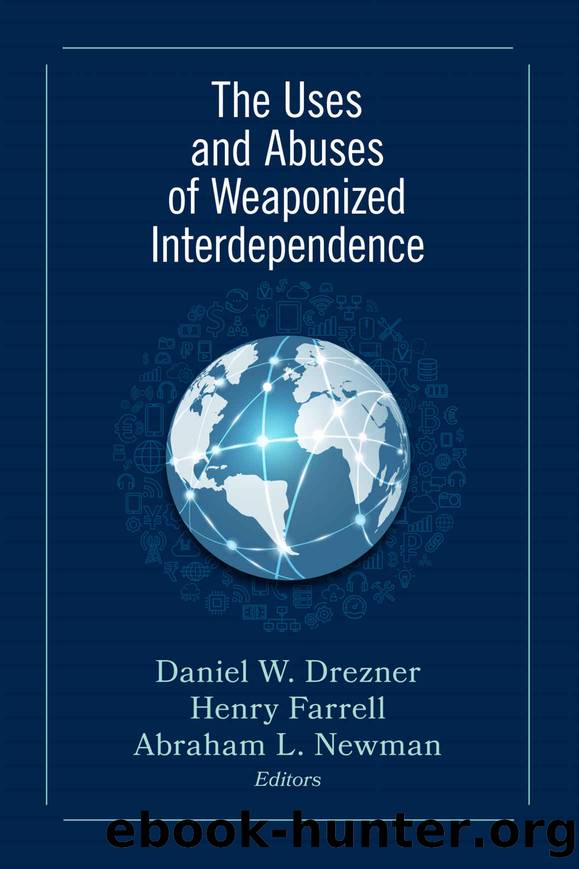The Uses and Abuses of Weaponized Interdependence by Henry Farrell & Abraham L. Newman Daniel W. Drezner

Author:Henry Farrell & Abraham L. Newman Daniel W. Drezner
Language: eng
Format: mobi
ISBN: 9780815738374
Publisher: Brookings Institution Press
Published: 2021-03-01T16:00:00+00:00
The Energy Transportation Network
The global energy transportation network physically moves oil and gas resources from supplier states to customer states. It has two modalities: pipelines and seaborne transit. Most oil resources travel by sea; approximately 40 MMb/d of crude oil, as well as substantial amounts of refined petroleum products, are shipped daily.13 Most gas travels by pipeline. However, the share of gas that travels by sea, in the form of liquified natural gas (LNG), is increasing annually.
Both transportation modes share a similar topography. Their nodes are the facilities through which energy resources exit supplier states and enter consumer states. In seaborne transportation, export and import terminals dispatch and receive energy resources. Pipelinesâ international exit and entry points may include pumping or monitoring stations. Both sets of nodes are owned and operated by private or state-owned companies.
The networkâs ties are the routes that energy resources travel between international exit and entry points. Some international pipeline routes, like the notorious Keystone XL oil pipeline between Canada and the United States, navigate only two states (cross-border pipelines). Others navigate three or more, fully traversing at least one (transit pipelines). Prominent transit pipelines include the BakuâTbilisiâCeyhan (BTC) oil pipeline, traveling from Azerbaijan to Turkey via Georgia, and the Yamal gas pipeline, traveling from Russia to Western Europe via Belarus. Authority over oil and gas pipelines is shared by multiple actors: the companies that own and operate them, and the national governments that host them. International pipelines are geographically fixed and, due to the cost of constructing them, few in number. If one is shut down, regional oil or gas transportation is significantly disrupted.
Seaborne oil and gas resources travel by tanker along standard global sea routes. Portions of these routes traverse the high seas, which are outside any stateâs jurisdiction. Some pass through international straits, where all ships enjoy the right of innocent passage. The most significant international straits for oil and LNG transportation are the Strait of Hormuz and Strait of Malacca. Over 17 MMb/d of crude oil transit the Strait of Hormuz, while over 15 MMb/d of crude transit the Strait of Malacca.14 Most maritime energy transportation routes are more flexible than pipeline transportation routes, because ships can change course. Nonetheless, there are exceptionsâmost prominently, the Strait of Hormuz. Deviating from other standard sea routes extends voyage lengths and marginally raises shipping costs.
Choke points are the key mechanism for weaponizing the energy transportation network. To choke off pipeline energy transportation, a state can physically suspend pipeline operations by activating shut-off valves and deactivating pumping stations. Only transit state governments are likely to attempt this maneuver, because energy suppliersâ and customersâ governments want to keep resources flowing. Transit state governments, in contrast, may want to increase transit fees or compel a supplierâs or customerâs government to change its behavior. To shut down pipeline transportation, a transit state government must wrest control from the pipelineâs operator, unless the operator is a transit state-owned enterprise.
To choke off seaborne energy transportation, a state has two options. First,
Download
This site does not store any files on its server. We only index and link to content provided by other sites. Please contact the content providers to delete copyright contents if any and email us, we'll remove relevant links or contents immediately.
Killers of the Flower Moon by David Grann(3761)
Machine Learning at Scale with H2O by Gregory Keys | David Whiting(3670)
Oathbringer (The Stormlight Archive, Book 3) by Brandon Sanderson(2668)
Will by Will Smith(2595)
Once Upon a Broken Heart by Stephanie Garber(2544)
Guns, Germs and Steel by Diamond Jared(2206)
Borders by unknow(2122)
It Starts With Us (It Ends with Us #2) by Colleen Hoover(2060)
The Room Where It Happened by John Bolton;(2039)
Friends, Lovers, and the Big Terrible Thing by Matthew Perry(2019)
The Color of Law by Richard Rothstein(1824)
HBR's 10 Must Reads 2022 by Harvard Business Review(1704)
The Strength In Our Scars by Bianca Sparacino(1702)
A Short History of War by Jeremy Black(1679)
Water Rights and the Environment in the United States by John Burch(1610)
Examples & Explanations: Administrative Law by William F. Funk & Richard H. Seamon(1557)
515945210 by Unknown(1526)
Pharmacy Practice and The Law by Richard Abood(1498)
That Every Man Be Armed by Stephen P. Halbrook(1483)
